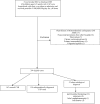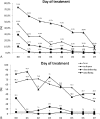Outcome of children hospitalized with community-acquired pneumonia treated with aqueous penicillin G
- PMID: 21437443
- PMCID: PMC3044566
- DOI: 10.1590/s1807-59322011000100017
Outcome of children hospitalized with community-acquired pneumonia treated with aqueous penicillin G
Abstract
Objective: To describe the evolution and outcome of children hospitalized with community-acquired pneumonia receiving penicillin.
Methods: A search was carried out for all hospitalized community-acquired pneumonia cases in a 37-month period. Inclusion criteria comprised age >2 months, intravenous penicillin G use at 200,000 IU/kg/day for >48 h and chest x-ray results. Confounders leading to exclusion included underlying debilitating or chronic pulmonary illnesses, nosocomial pneumonia or transference to another hospital. Pneumonia was confirmed if a pulmonary infiltrate or pleural effusion was described by an independent radiologist blind to the clinical information. Data on admission and evolution were entered on a standardized form.
Results: Of 154 studied cases, 123 (80%) and 40 (26%) had pulmonary infiltrate or pleural effusion, respectively. Penicilli was substituted by other antibiotics in 28 (18%) patients, in whom the sole significant decrease was in the frequency of tachypnea from the first to the second day of treatment (86% vs. 50%, p = 0.008). Among patients treated exclusively with penicillin G, fever (46% vs. 26%, p = 0.002), tachypnea (74% vs. 59%, p = 0.003), chest indrawing (29% vs. 13%, p<0.001) and nasal flaring (10% vs. 1.6%, p = 0.001) frequencies significantly decreased from admission to the first day of treatment. Patients treated with other antimicrobial agents stayed longer in the hospital than those treated solely with penicillin G (16 ± 6 vs. 8 ± 4 days, p<0.001, mean difference (95% confidence interval) 8 (6-10)). None of the studied patients died.
Conclusion: Penicillin G successfully treated 82% (126/154) of the study group and improvement was marked on the first day of treatment.
Figures


Similar articles
-
Community-acquired pneumonia among children: the latest evidence for an updated management.J Pediatr (Rio J). 2020 Mar-Apr;96 Suppl 1(Suppl 1):29-38. doi: 10.1016/j.jped.2019.08.003. Epub 2019 Sep 10. J Pediatr (Rio J). 2020. PMID: 31518547 Free PMC article. Review.
-
Differences upon admission and in hospital course of children hospitalized with community-acquired pneumonia with or without radiologically-confirmed pneumonia: a retrospective cohort study.BMC Pediatr. 2015 Oct 23;15:166. doi: 10.1186/s12887-015-0485-6. BMC Pediatr. 2015. PMID: 26496953 Free PMC article.
-
Retrospective analysis of the efficacies of two different regimens of aqueous penicillin G administered to children with pneumonia.Antimicrob Agents Chemother. 2014;58(3):1343-7. doi: 10.1128/AAC.01951-13. Epub 2013 Dec 16. Antimicrob Agents Chemother. 2014. PMID: 24342647 Free PMC article.
-
Comparison of oral amoxicillin and intravenous benzyl penicillin for community acquired pneumonia in children (PIVOT trial): a multicentre pragmatic randomised controlled equivalence trial.Thorax. 2007 Dec;62(12):1102-6. doi: 10.1136/thx.2006.074906. Epub 2007 Jun 13. Thorax. 2007. PMID: 17567657 Free PMC article. Clinical Trial.
-
Childhood community-acquired pneumonia.Semin Respir Infect. 1999 Jun;14(2):163-72. Semin Respir Infect. 1999. PMID: 10391410 Review.
Cited by
-
Pediatrics in Clinics: highlights.Clinics (Sao Paulo). 2012 Aug;67(8):859-64. doi: 10.6061/clinics/2012(08)01. Clinics (Sao Paulo). 2012. PMID: 22948450 Free PMC article. No abstract available.
-
Effects of clinical pathway implementation on antibiotic prescriptions for pediatric community-acquired pneumonia.PLoS One. 2018 Feb 28;13(2):e0193581. doi: 10.1371/journal.pone.0193581. eCollection 2018. PLoS One. 2018. PMID: 29489898 Free PMC article.
-
Community-acquired pneumonia among children: the latest evidence for an updated management.J Pediatr (Rio J). 2020 Mar-Apr;96 Suppl 1(Suppl 1):29-38. doi: 10.1016/j.jped.2019.08.003. Epub 2019 Sep 10. J Pediatr (Rio J). 2020. PMID: 31518547 Free PMC article. Review.
-
Differences upon admission and in hospital course of children hospitalized with community-acquired pneumonia with or without radiologically-confirmed pneumonia: a retrospective cohort study.BMC Pediatr. 2015 Oct 23;15:166. doi: 10.1186/s12887-015-0485-6. BMC Pediatr. 2015. PMID: 26496953 Free PMC article.
References
-
- Mulholland K. Childhood pneumonia mortality – a permanent global emergency. Lancet. 2007;370:285–9. 10.1016/S0140‐6736(07)61130‐1 - DOI - PubMed
-
- Farha T, Thomson AH. The burden of pneumonia in children in the developed world. Paediatr Respir Rev. 2005;6:76–82. 10.1016/j.prrv.2005.03.001 - DOI - PubMed
-
- Sazawal S, Black RE. Effect of pneumonia case management on mortality in neonates, infants, and preschool children: a meta‐analysis of community‐based trials. Lancet Infect Dis. 2003;3:547–56. 10.1016/S1473‐3099(03)00737‐0 - DOI - PubMed
-
- Dowell SF, Kupronis BA, Zell ER, Shay DK. Mortality from pneumonia in children in the United States, 1939 through 1996. N Engl J Med. 2000;342:1399–407. 10.1056/NEJM200005113421904 - DOI - PubMed
-
- World Health Organization. A manual for doctors and other senior health workers. Programme for the Control of ARI. Geneva: WHO; 1990. ARI in children: case management in small hospitals in developing countries.
MeSH terms
Substances
LinkOut - more resources
Full Text Sources
Medical

